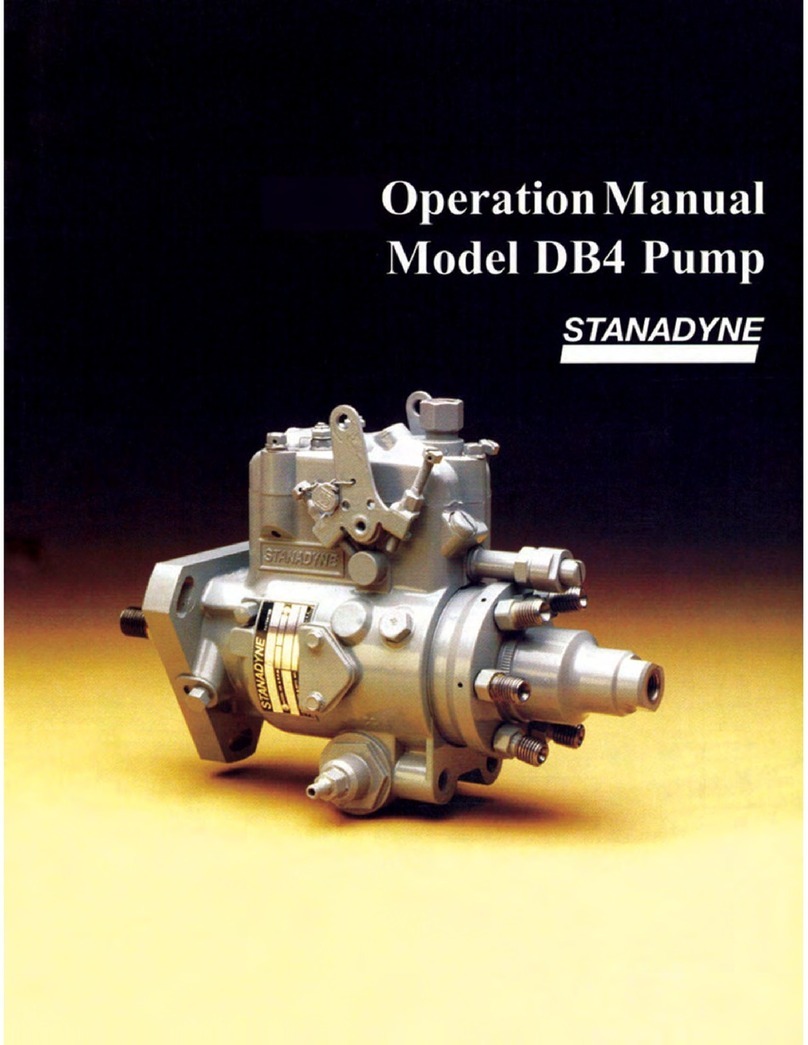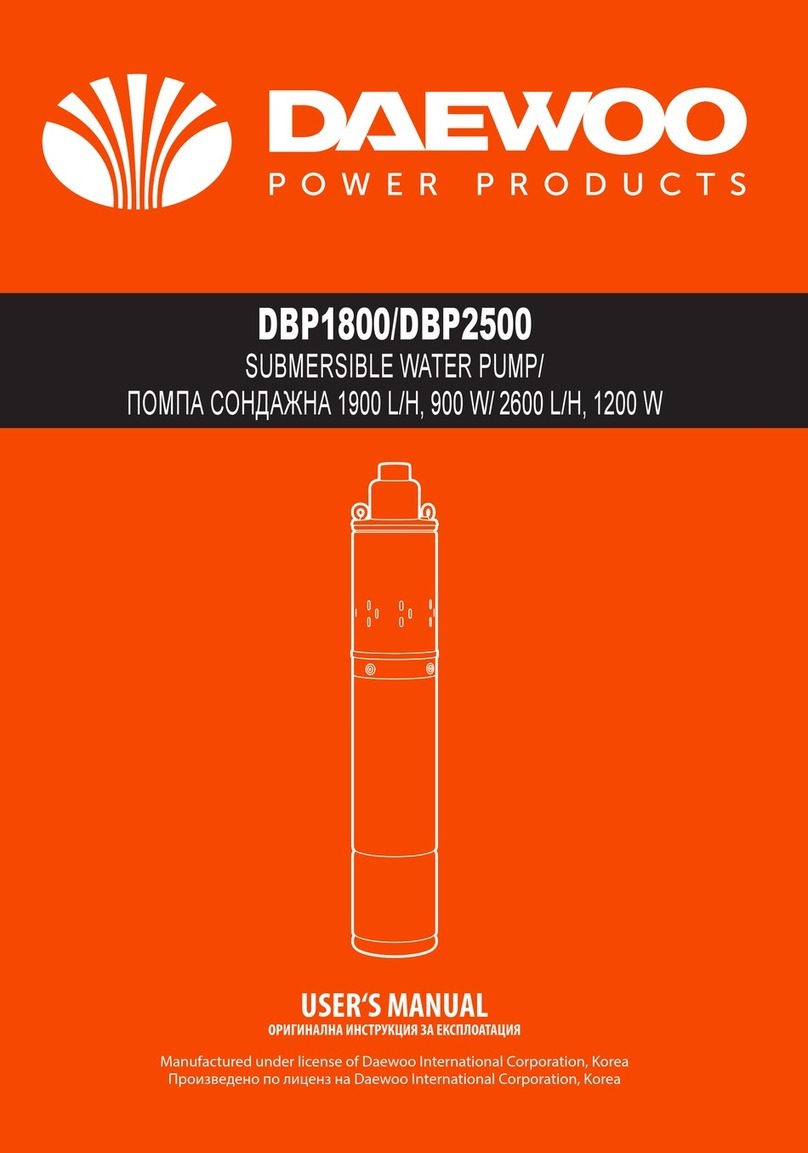JEC Pumps AccuLAB Series Installation and operation manual

Operating & Maintenance Manual
JEC AccuLAB Series
Rotary Lobe Pumps

1
CONTENTS
GENERAL
General Information -----------------------------------------------------------------------
Intended Use -------------------------------------------------------------------------------
CERTIFICATES
ATEX (European Explosive Proof Certificate) ------------------------------------------
EC(Declaration of conformity) -----------------------------------------------------------
1935/2004(EC) -----------------------------------------------------------------------------
FDA ------------------------------------------------------------------------------------------
SAFETY
DO’S and DON’TS --------------------------------------------------------------------------
Warranty ------------------------------------------------------------------------------------
INSTALLATION
Installation ----------------------------------------------------------------------------------
Start Up --------------------------------------------------------------------------------------
TROUBLESHOOTING
Troubleshooting ----------------------------------------------------------------------------
MAINTENANCE
Disassembly ---------------------------------------------------------------------------------
Inspection -----------------------------------------------------------------------------------
Pump housing assembly ------------------------------------------------------------------
Shaft and bearing replacement ----------------------------------------------------------
Seal assembly -------------------------------------------------------------------------------
Rotor Clearance ----------------------------------------------------------------------------
Rotor Timing --------------------------------------------------------------------------------
Gearbox Assembly -------------------------------------------------------------------------
TECHNICAL INFORMATION
Technical Data ------------------------------------------------------------------------------
Dimensional Drawing ----------------------------------------------------------------------
PARTS LIST
Cross-Sectional View ----------------------------------------------------------------------
Parts List ------------------------------------------------------------------------------------
2
2
3
4
5
6
7
8
9
9
10
11
13
14
15
17
18
19
20
21
22
23
24

2
GENERAL
GENERAL INFORMATION
Thank you for your purchasing JEC products!
This manual is a part of the AccuLAB describes safe and appropriate operation during
operating and in all life cycles.
This contains instructions for installation, operation, disassembly and assembly, maintenance
procedures, troubleshooting and a complete parts list for all.
Read and completely understand this manual to learn how to service these pumps prior to
operating or servicing product and observe to pay special attention to the warnings.
This must always be available at the installation location since no liability will be assumed for
any damage or operational malfunctions arising from non-compliance with these operating
instructions.
INTENDED USE
The pump is only to be used for the media pumping agreed in the applicable data sheet or
specification. Any other application beyond the intended use or conversion of the pump
without written agreement with the manufacturer shall be deemed to be not in accordance
with the intended use.
The pump may only be started up for the first time if it has been ensured that all safety
devices are completely fitted and functional.
If any areas are subject to have the risk of explosion, the relevant explosion-proof designed
pumps to be used.
Intended use also covers compliance with the conditions of operation, servicing and
maintenance specified by the manufacturer.
The pump is only to be put into operation filled with medium to be pumped.
Before starting up ensure that;
- Open the valves on the suction side completely to avoid cavitation and,
- Open the valves on the discharge side open completely to avoid exceeding the permitted
differential pressure of the pump
-Discharge-side safety measures should be done (e.g. safety valve) to protect the pump
from non-permitted excess pressure
-Protection against contact for hot, cold and moving parts must not be removed during
operation

3

4

5

6

7
SAFETY
DO’S & DON’TS
DO read and understand these instructions before installing or using the pump.
DO use JEC spare parts when replacing a component of the pump.
DO NOT services the pump while it is running.
DO NOT place the pump in an application where the service ratings are exceeded.
DO NOT modifies the pump. Modifying the pump creates unsafe conditions and voids all
warranties.
SAFETY PRECAUTIONS WHEN INSTALLING PUMP
DO use an authorized electrician when connecting the pump.
DO observe the mechanical limits of the pump (refer to the pump performance sheet).
DO install a throttling valve in the discharge line.
DO NOT installs a throttling valve in the suction line.
SAFETY PRECAUTIONS WHEN OPERATING PUMP
DO only qualified personnel should operate this pump.
DO NOT start the pump until all personnel are clear.
DO NOT touches the pump or the lines when pumping hot fluids or when performing
Clean In Place (CIP) procedures.
DO NOT run the pump with BOTH the suction inlet and discharge outlet blocked. Running
the pump with the inlet the blocked will cause serious damage to the pump.
DO NOT checks pump rotation with liquid in the pump.
DO NOT runs the pump with the front cover removed. The screws and screw case could
be damaged or may cause severe injury.
DO NOT operates the pump with removed the safety guard or shroud.
SAFATY PRECAUTIONS WHEN SERVICING PUMP
DO ensure the pump is cool to touch before performing service.
DO relieve all pressure and drain all fluids from pump and connected piping before
performing service.
DO ENSURE POWER TO THE UNIT HAS BEEN UNPLUGGED PRIOR TO
PERFORMING ANY PUMP MAINTENANCE OR CLEANING.
DO exercise caution and wear protective clothing when using lye or acid for cleaning.

8
WARRANTY
TERMS & CONDITIONS
All terms & conditions and prices of sale are based on the applicable JEC price list at the
time an order from Customer is received by JEC and are subject to change without
notice. No assignment of the purchaser’s rights may be made without consent of JEC.
JEC warrants its Product from defects in materials and workmanship for a period of one
(1) year from the shipment date, providing it has been used as recommended and in
accordance with recognized piping practice, and providing it has not been worn out due
to severe service, normal tea and wear or subjected to accident, misuse or improper
maintenance. This warranty extends only to the original Buyer.
This warranty is expressly in lieu of any other warranties expressed or implied, including
but not limited to any implied warranty of merchantability or fitness for a particular
purpose.
All claims must be in writing and must be mailed or delivered by purchaser within thirty
(30) days after purchaser learns of the facts upon which such claim is based. Any claim
not made in writing and within the time period specified above shall be deemed waived.
Purchaser’s sole and exclusive remedy and JEC Ltd.’s maximum liability for claims arising
hereunder or for negligence for any and all losses and damages resulting from any cause
shall be either the repair or replacement of defective components or pumps verified by
JEC.
In no event, including in the case of a claim for negligence, shall JEC Ltd. be liable for
incidental or consequential damages including loss of profits.
No person, including any representative, employee or agent of JEC, is authorized to
assume on behalf of JEC, any liability or responsibility in addition to or different from
that described in this provision. Any and all representations, promises, warranties or
statements that are in addition to or different from the terms of this provision are of no
force or effects.
RECEIVING INSPECTION
Ports are rubber capped at the factory to keep out foreign objects. If covers are missing
or damaged, a thorough inspection of fluid head, by removing pump cover, is
recommended. Be sure pumping head is clean and free of foreign material before
rotating shaft.
LOSS OR DAMAGE
If your pump has been lost or damaged in transit, immediately file a claim at once with
the delivering carrier and ask for an Inspector to call. The carrier has signed the Bill of
Lading acknowledging that the shipment has been received from us in good condition.
We shall assist you in every way in collecting claims for loss, or damage, however, we
are not responsible for the collection of claims or replacement of material.

9
INSTALLATION
INSTALLATION
1. Mounting surface should be flat and level.
2. The suction line should be kept as short as possible and present minimum friction
loss.
3. Suction and discharge lines must be fully supported and installed so that no
expansion or shock forces act on the pump which could lead to a bad influence.
4. Ensure sufficient clearance around the motor and pump.
START UP
1. Before connecting the suction and discharge pipe work the entire system must be
thoroughly cleaned to prevent damage from welding, grinding and other residues.
2. Before starting, bump the motor to check if the motor fan is rotating count-clockwise
when seen from the motor back. If the motor fan cannot be seen, look through the
pump case adaptor after takeoff motor shroud. (Bump means to momentarily apply
power to the motor and then immediately remove power).
3. Direction of rotating must only be checked with a completely filed system. Where
double mechanical shaft seals are installed the flush supply must be operational. Any
dry running will result in seal damage.
4. The motor rating plate should be checked to ensure that it is in accordance with the
available electrical supply. It is essential that the full load current is not exceeded to
prevent motor overload.
5. Before start up any safety guards required by local statutory regulations should be
fitted.
Pay attention to circumstances that could indicate pump cavitation;
1. Low pressure in the suction line due to bad suction conditions.
2. Air in the suction-line.
3. Pumping temperature is too high.
4. Pump is oversized.

10
TROUBLESHOOTING
Problem
Cause
Solution
Pump not turning
Interruption of electrical power.
Key sheared or missing.
Coupler or belts are not connected.
Pump shaft or gears sheared.
Wrong rotation.
Relief valve not properly adjusted.
Reset circuit breaker, check fuses.
Replace.
Replace or adjust.
Replace.
Reverse.
Adjust valve.
Pump not priming
Valve closed in suction lines.
Suction line clogged or restricted.
Air leak in connections or seal.
Pump speed too slow.
Suction line does not remain flooded.
Air lock.
Excessive clearances in pump.
Net inlet pressure low.
Open valve.
Clear suction line.
Repair leak.
Increase speed.
Install foot valve.
Bleed suction line.
Replace out of tolerance parts
Increase suction pressure
Insufficient flow
Speed too low.
Air leak.
Adjust speed as required.
Repair leak.
Noisy operation
Cavitation.
Viscous product.
High vapor pressure, high temp.
Leaks in piping or pump.
Dissolved gas in product.
Mechanical noise.
Excessive weight from piping,
Pump body distorted.
Excessive discharge pressure.
Worn bearing.
Worn gears.
Rotor-to-Rotor contact.
Increase net inlet pressure.
Slow pump, reduce product.
Reduce temperature.
Repair leaks.
Reduce discharge pressure.
Check tolerances.
Support piping.
Check align and level
Reduce discharge pressure.
Replace bearing.
Replace gears
Timing screws, replace twisted shafts,
replace worn gears.
Pump overloads
Viscosity of product higher than
expected.
Higher pressure than expected.
Reduce pump speed, increase
pipe size,
Reduce pump speed, increase
pipe size,
Play between gears
Worn gear teeth.
Gear loose on shaft.
Replace gear.
Inspect gear key, keyway and shaft.
If all are undamaged, retighten the
gear retaining nut.
Check for backlash.
If assistance is required, please contact your local sales office with the following information:
1. Operating conditions.
2. Accurate description of default.
3. Model of pump and serial number.
4. If possible installations sketch of pump system.

11
MAINTENANCE
PUMP HOUSING DISASSEMBLY
Prior to removal of pump, the shut-off valves in the suction and discharge pipe work must
be closed. If there is any risk that product may be hardened, crystallized or frozen in the
pump it should be thoroughly drained and cleaned immediately after use. Similar attention
must be applied to the seal flushing system. Remove power before servicing to prevent
from any unintended start of the pump by an authorized electrician.
Drain all products from the pump head prior to disassembly. The pump head may be
isolated with inlet and outlet valves. And disconnect the suction and discharge piping from
the pump.
Loosen and remove the four-cover bolts from the cover.
Remove the cover. If it is stuck, tap on the cover with a soft
hammer. Remove the cover O-ring.
Remove rotor-retaining bolts. Use the special tool supplied
with pump. To remove rotor-retaining bolts, place the plastic
dowel between the rotors. Turn the first rotor bolt counter-
clockwise.
The rotors can be removed from the pump housing by pulling
straight. If it is stuck tight, alternately use special rotor
extraction tool supplied with pump. Handle the rotors with
care to avoid damage.
Fig. 1
Fig.2
Figure 1
Fig. 3

12
The shims behind of rotors should be carefully maintained not
to be lost or damaged in order to use when assembling.
In order to remove stationary seals, both of seal stopper/pin
on the top and bottom should be loosened as shown.
Rotary seal rings are being installed into rotors with rotary
seal ring rubber cap.
Remove seals body from housing.
The seals can be easily moved forward by using minus (-)
driver as shown.
Fig. 4
Fig. 5
Fig. 6
Fig. 7
Fig. 8

13
INSPECTION
1. Inspect O-rings and seals for reuse. Worn O-rings and seals should be replaced.
2. Inspect seal faces for scoring or cracks. Replace any seal faces that are damaged.
3. Inspect shaft shoulder matched to rotors and other metal parts for wear or damage.
4. Inspect rotor galling sign among the rotor housing, front cover and rotors. Must be remove
it or replaced.
5. Inspect bur of the rotor bolt groove. Must be remove it or replaced

14
PUMP HOUSING ASSEMBLY
Before assembly, make sure to clean the surface of all parts.
Assembly can be done reverse way against the disassembling procedure.
After replacing the old seals with new seals, put the
shims into shaft.
Assemble a rotor onto shafts. Make sure seal side first
into the shaft.
Tighten the first rotor bolt with a special tool to the
recommended torque. To tighten the second rotor place
the plastic dowel on the opposite side of the rotor and
tighten the second rotor bolt to the proper torque.
.
Excessive torque could make rotor bolts damaged or its
surface produced bur. If a bur is raised, it should be
removed by sander paper smoothly.
Install the cover and tighten the front cover bolts.
Use feeler gauges and depth micrometer to verify the back and redial clearances
between the rotors and the housing. A depth gauge should be used to verify the
front clearance
Fig. 9
Fig. 10
Fig. 11
Fig. 13

15
SHAFT AND BEARING REPLACEMENT
The pump, when operating, can cause SEVERE INJURY to anyone in contact with the rotating
parts. Turn off the energy source and LOCK OUT before dismantling pump. Use a locking
device for which only the person doing the dismantling has the key.
AccuLAB series has a single body combined pump housing with
gear housing. Generally, gear housing is no needed for the
maintenance (disassembly or assembly) except filling grease into bearing and
gear or maintenance for the gear. If gear housing is needed for the maintenance,
experts with special care should do the work.
WARNING
Dismantle pump bracket by removing the four bracket
bolts.
Then, dismantle the cover of gearbox by removing four
bolts.
Remove the lock nut and washer from the drive shaft
and idle shaft.
Pull the two gears off the pump shafts. Remove the gear
keys.
Fig. 14
Fig. 15
Fig. 16
Fig. 17

16
Remove two long bolts securing bearing cover.
Bearing is firmly secured and so, after hitting the shaft
from the front with soft hammer and bearing can be
dismantled easily by using two long bolts as shown.
Be careful not to damage the shaft with
excess hitting.
WARNING
Bearings on drive and idle shaft can be dismantled.
Shim should be carefully kept not to be lost for the
assembly.
Quad ring is protecting bearing when a leakage occurs.
Fig. 22
Fig. 18
Fig. 19
Fig. 20
Fig. 21

17
SEAL ASSEMBLY
Install Slinger O-Ring (4.9) onto the shaft ensuring the O-ring is all the way up the shaft
and against the pump body bore face. This is also visible through the slots in the sides of
the pump body.
•Install external O-rings (4.5) and internal Quad-ring (4.8) to the Seal body (4.5)
•Install the seal housing into the pump assembly. Aligning the flush holes with the
tapping in the pump body.
•Install the flush locking adapter O-ring onto the adapter (5.1).
•Install the flush locking adapter (5.1) such that the end of the component is locking
the seal body in position.
•Install the primary O-ring (4.6) onto the Static Seal (4.3).
•Install the static seal face (4.3) aligning the slots in the seal face with the anti-rotation
pins in the seal body.
•Install the rotor and rotary seal face assembly.
Fig. 23

18
ROTOR CLEARANCE
Rotor clearance must be precisely maintained to provide maximum pumping
efficiency, yet prevent contact between rotors, rotor housing, and front cover
during operation. If pumping efficiency is below expectations, or if parts contact has occurred
during operation (Within rated differential pressure), check, rotor clearances and adjust if
incorrect.
Metric (mm)
Front ‘A’
Rear ‘B’
Radials ‘C’
Mesh ‘D’
0.07
0.07
0.07~0.09
0.07~0.09
Imperial (inches)
Front ‘A’
Rear ‘B’
Radials ‘C’
Mesh ‘D’
0.0039
0.0039
0.0039
0.0039
There are two areas of rotor clearances as illustrated following:
Rotor tip clearance –not adjustable and set by manufacturer
Front and back face clearance –adjustable by shim
Rotor width and body depth are fixed at manufacture. Therefore, with the correct rotor(1.1) size
selected, the only maintenance adjustment that can be made is the proportion of front and rear
clearance. Measure the front clearance as follows:
1. The rotor to rotor housing back face clearance is maintained by the shim plate ( ).
2. Check the rotor bolts (3.5) are tight.
3. Measure the clearance between the back face of the pump housing and the back of the rotor
with a filler gauge. Check the reading with the recommended back face clearance.
4. If incorrect, adjust by adding or removing shim plates from behind the rotors
5. Check each rotor and adjust as necessary.
CAUTION
Fig. 24

19
ROTOR TIMING
Rotor timing must be precisely maintained to provide maximum pumping efficiency, yet prevent
contact between rotors during operation. If pumping efficiency is below expectations, or if rotors
contact during operation (within rated differential pressure), check rotor timing and adjust if
incorrect. Also check rotor timing after any gearbox dismantling when the gears are removed
and/or replaced.
Check Rotor timing as follows:
1. Assemble each rotor (1.1) in its normal location on the drive shaft and the idle shaft.
Assemble each rotor bolt (3.5) and tighten hand tight.
2. Rotate the shafts 30 degrees and measure gap as illustrated by arrows. Rotate the shafts 60
degrees the opposite direction and measure gap as illustrated.
3. The Rotors are correctly timed when the gap measured at both locations are equal. If the
gap is unequal, adjust the timing as follows.
4. Rotor timing is determined by the relative
location of the two helical gears (3.2) on
the shafts.
5. Place the wooden dowel between
the rotors.
6. Bend away the tab of the lock washer
(3.3) on one shaft. Loosen the lock
nut and temporarily insert shim stock
between the gear and gear spacer.
Tighten the lock nut, reassemble the
rotor in its correct location, and
recheck rotor timing.
* If Rotor timing is correct, remove the gear and replace added other spacer or add a shim
equal in thickness to the shim stock temporarily added. Reassembly the gear and gear nut,
tighten to the correct torque, and check rotor timing again to confirm that it is correct.
* If rotor timing is incorrect, but closer to equal than original measurement, repeat previous
step adding addition shim stock.
* If rotor timing is incorrect and more unequal than original measurement, remove temporary
shim stock from one shaft and add instead to the other shaft.
7. Repeat above procedures until the timing gap is equal after gear spacers are in place and
gear nuts are tightened to correct torque.
8. Reassemble pump.
Fig. 25
Table of contents
Other JEC Pumps Water Pump manuals
Popular Water Pump manuals by other brands
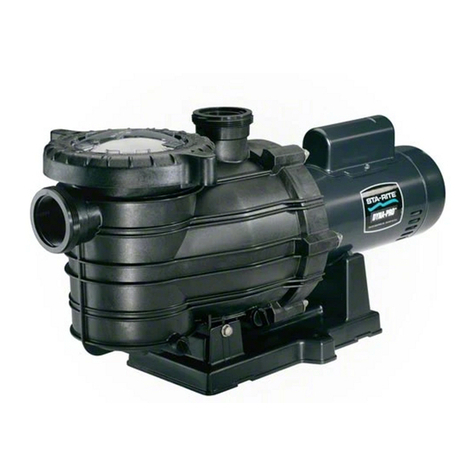
STA-RITE
STA-RITE DYNA-WAVE MPRA Series owner's manual

Beckett
Beckett Fountain Pump M400AUL16 Specifications

JB INDUSTRIES
JB INDUSTRIES ELIMINATOR operating manual

Stoelting
Stoelting 219 owner's manual
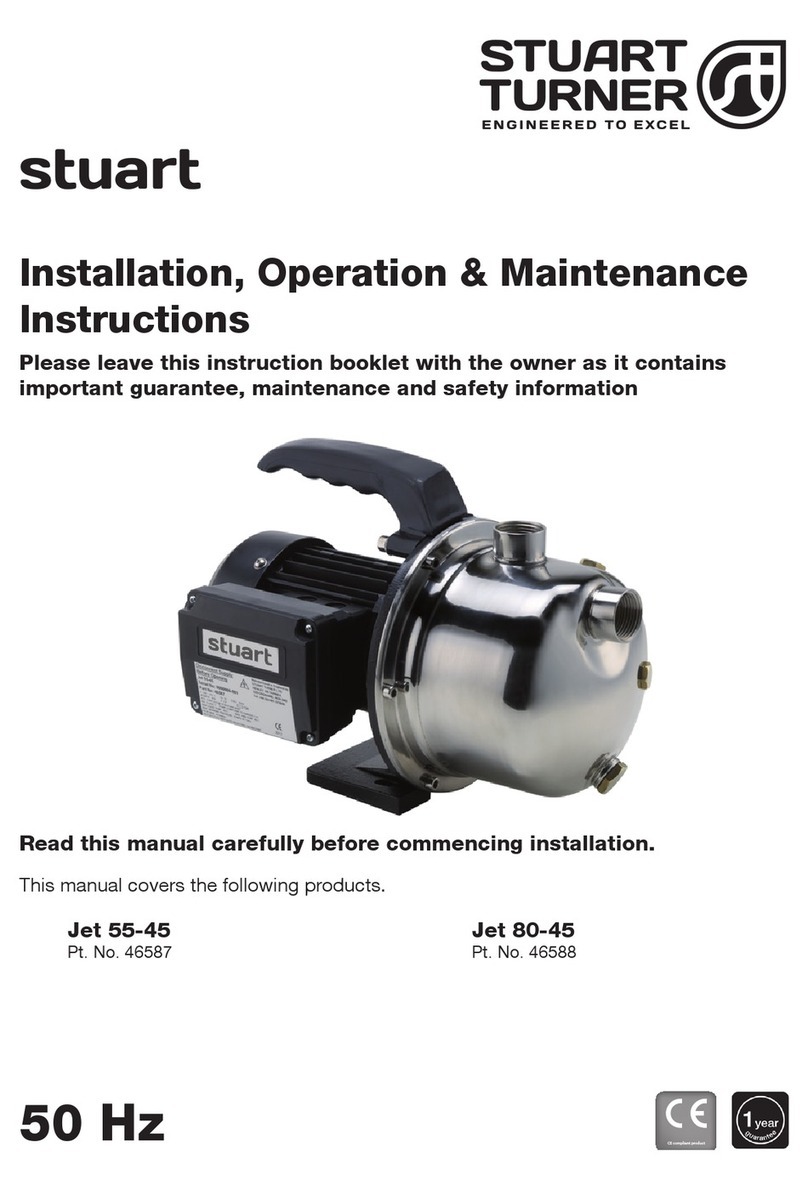
Stuart
Stuart Jet 55-45 Installation, operation & maintenance instructions
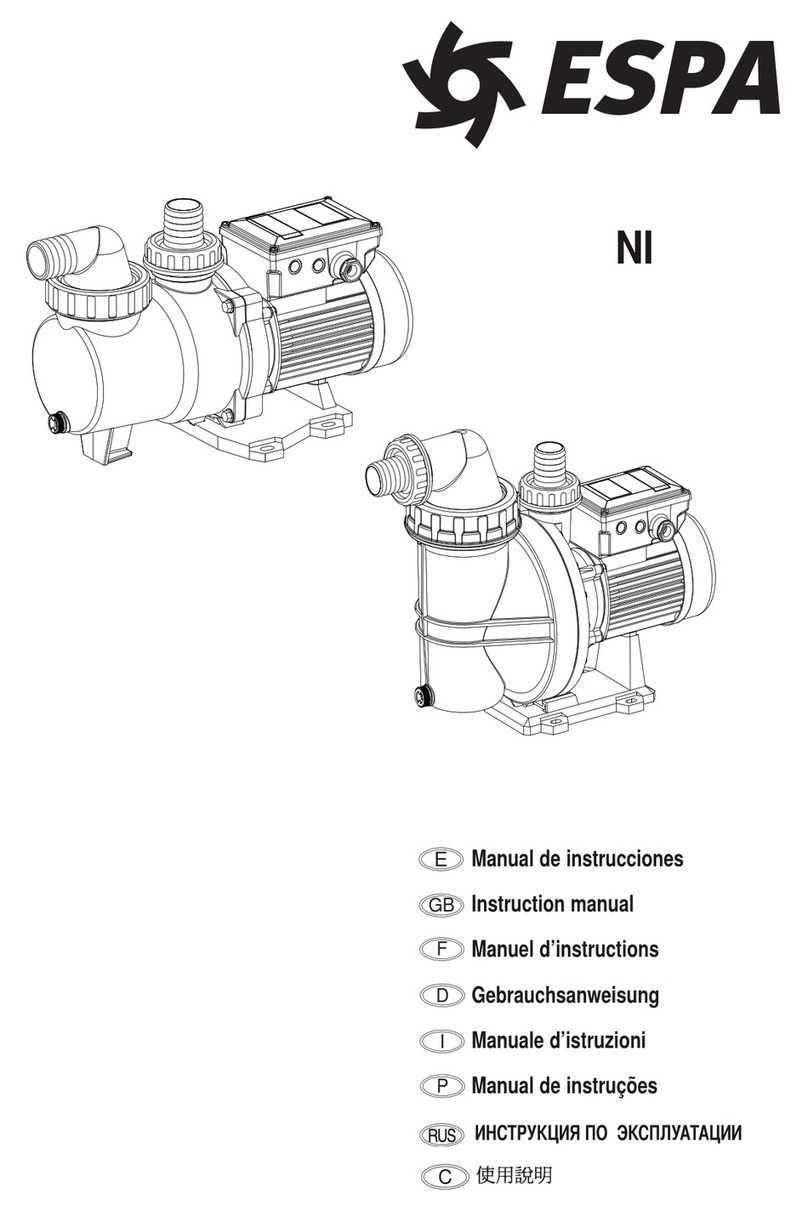
Espa
Espa NI instruction manual
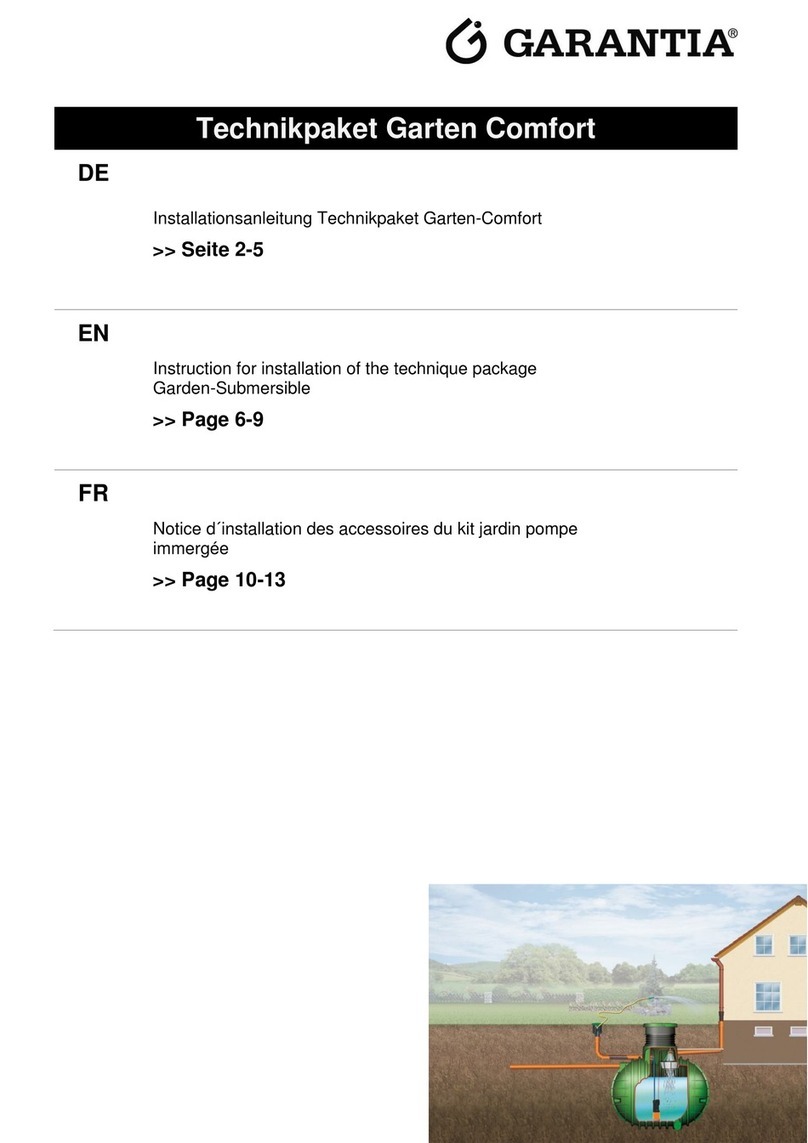
Graf
Graf 202561 Instructions for installation
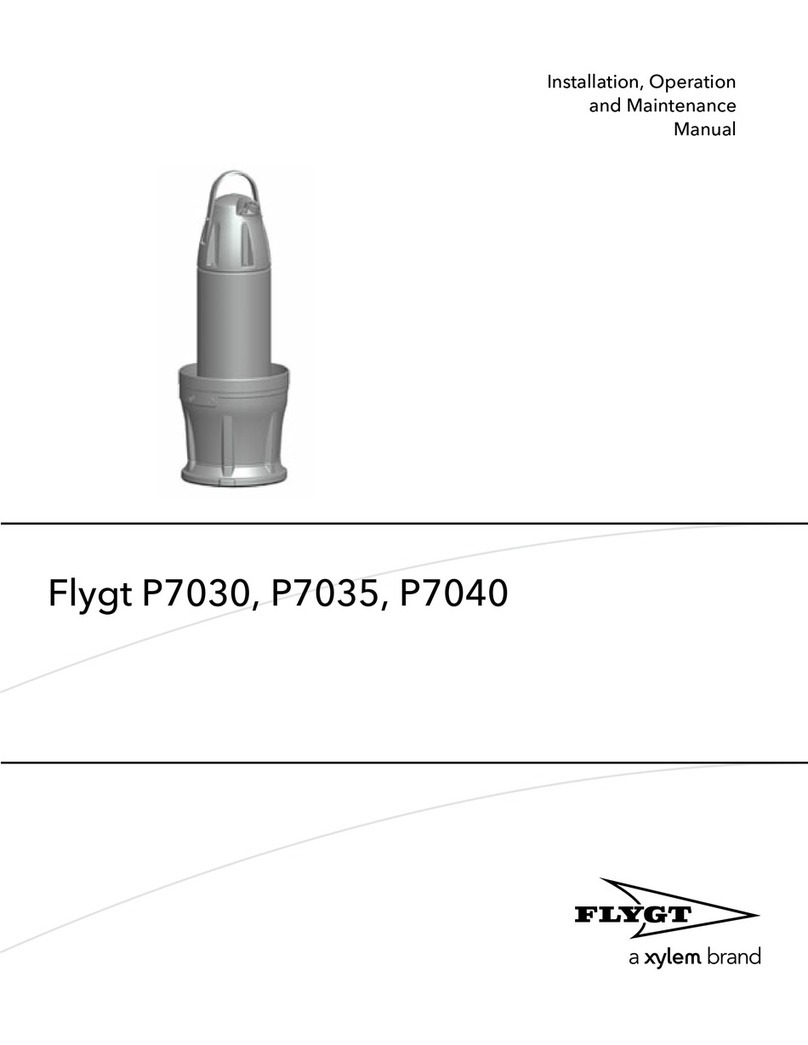
FLYGT
FLYGT P7030 Installation, operation and maintenance manual
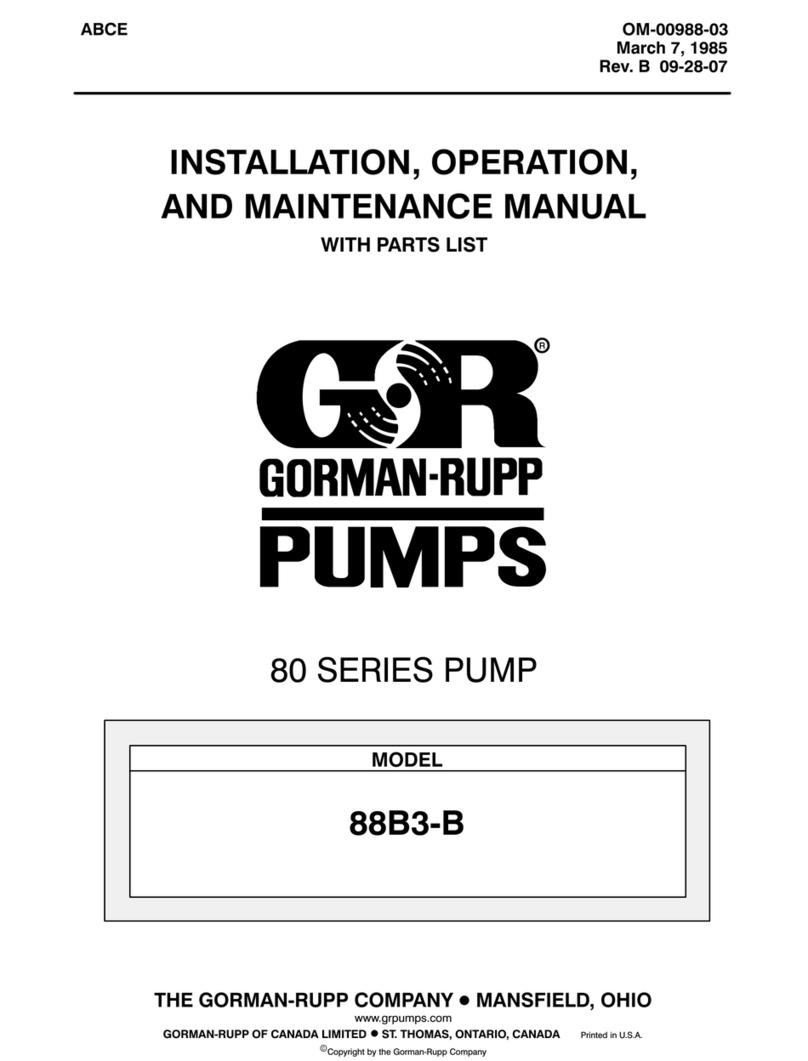
GORMAN-RUPP
GORMAN-RUPP 88B3-B Installation, operation and maintenance manual
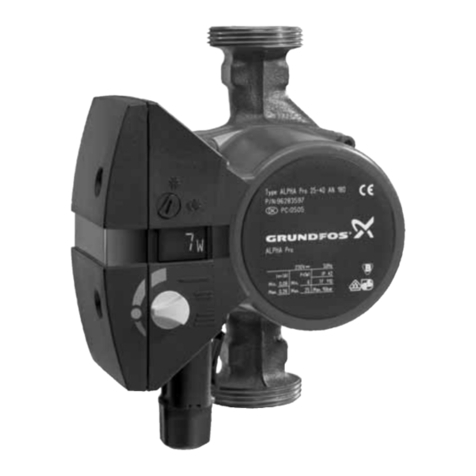
Grundfos
Grundfos ALPHA Pro Installation and operating instructions

T.I.P.
T.I.P. DHWA 4000/5 LED operating instructions

Graco
Graco Husky 1050HP Operation



